Introduction to Meditation in 5 Simple, Profound Steps, SPRING TERM
April 25, 2019 July 11, 2019
SERIES OF CLASSES
Total # of Classes
10
Class length
75 minutes
Location
305 East Duval Street, Suite 101, Lake City, FL 32055
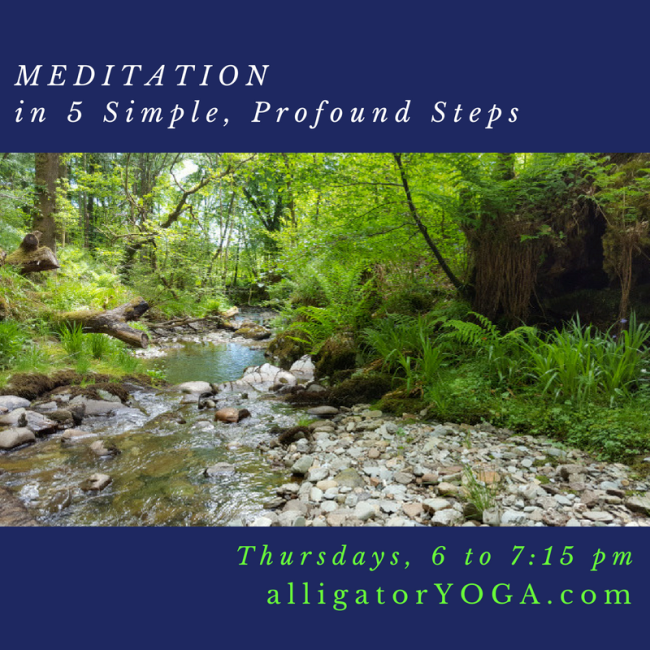
Meditation is a systematic process that leads you from outside to inside—from the environment around you to the quietness of your own mind. It relaxes the nervous system, calms the senses, and focuses the mind.
This 10-week course will focus upon two main themes in meditation: mindfulness, or the ability to observe yourself, and concentration, the ability to rest your mind in its focus. In meditation, body, breath, and mind need to be integrated into one continuous process.
Come learn how to relax your body and breath, focus your mind, and sit resting in a place of stillness inside yourself—in five easy steps. With these meditation essentials, you will have the tools you need to discover your own inner sanctuary.
Together over 10 weeks we will progressively explore and experience how to:
- Prepare the body and mind for meditation;
- Choose a sitting posture that’s just right for you;
- Practice smooth, relaxed breathing, and awareness of the flow of the breath;
- Use a simple mantra as a focus and resting place for the mind;
- Observe yourself and the thoughts that arise as you meditate; and
- Truly take the time and space to notice how you feel during and after meditation.
This course follows a simple yet reliable step-by-step method of meditation in the Himalayan Tradition. Anyone can do it. Though the approach is simple, the results are often quite surprising and enrich over time. At the beginning of the course, we will review misconceptions about meditation, including the notion that it is a difficult, mystical experience hard to attain or that it is an emptying of the mind. We will also clarify a precise understanding of meditation, since popular culture often presents it as so inclusive that it loses its meaning and potency. Meditation is sequential practice, with order and form, and we should follow it daily. Understanding the process makes it more reliable.
Each week, we will first do the preparatory work that supports meditation: Tension release; breath training; improved diaphragmatic breathing; systematic relaxation; and finally, formal seated meditation.
Class opens with a brief discussion of the focal point for the week, all based in time-tested yogic philosophy. We then begin standing and do very simple movements and stretches to release tension in the body. We will also practice breath training to strengthen the diaphragm while also activating the rest and digest response of the nervous sytem. This can be done seated or lying down, and often uses a weight on the abdomen. We will also work with breath awareness to ensure that you are breathing diaphragmatically. Each week we will review and practice the 5 essential qualities of optimal diaphragmatic breathing: smooth, deep, even, continuous, and quiet.
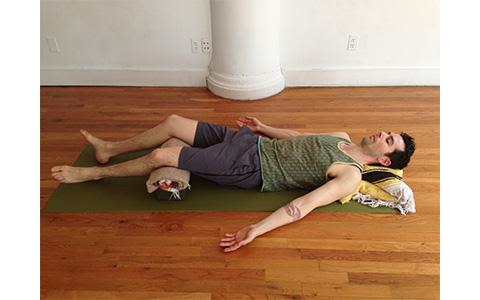
Then, we move into systematic guided relaxation. This is an essential step that is often overlooked or not fully appreciated. Relaxation will occur as you lie on your yoga mat, using blankets, bolsters and other props as needed to ensure your comfort and support. Relaxation practices are traditional, systematic, and step-by-step methods. They are done lying down because this allows you to progressively and therefore more fully & deeply relax the body, soften nervous agitation, and quietly calm the mind.
Precise techniques are used to shift your attention from the outer world to your own body and become aware of the flow of your breath. We will approach meditation through techniques such as 61-points (Sithila Karani) and Breath Wave (Shavayatra) exercise. With each of these methods, your awareness travels to each area of the body as you relax and soften each area. This not only enhances breathing and soothes the physical body; it also provides support and focus for the mind in such a way that richly develops the inward turn. Finally, you sense how you are the quiet observer of your body and breath as your mind rests in the feeling of breathing and you relax your body, breathing, nervous system, senses, and mind. This portion of each session lasts for at least 25 minutes.
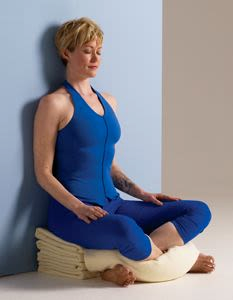
These essential preparatory steps enable a truly deep, settled, and fruitful meditation practice that concentrates and refreshes the mind. After guided systematic relaxation, students are gently directed into seated positions of their choice. Great care and training is provided to introduce various possibilities of seated postures, as this is the essence of the physical yoga practice. Students are encouraged to use supports--including a chair--in order to find a posture that is just right, where the head and trunk are properly aligned and supported directly over the pelvis. Sitting does indeed take practice!
Then the course will guide the the 5 essential steps of Meditation:
1. Stillness;
2. Relaxed and Effortless Breathing;
3. Systematic Relaxation while seated;
4. Breath Awareness at the Nostrils; and
5. Resting Awareness in the Sound of a Mantra.
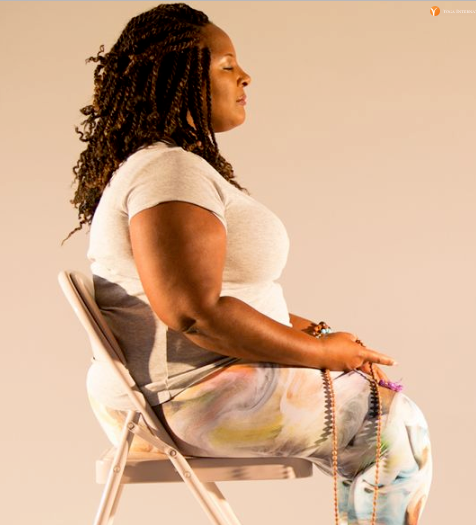
The course will include discussion of how popular practices now known as "yoga" (postures of hatha yoga) are actually intended to be of service to meditation. We will review in both conceptual theory and actual practice how this approach to meditation is grounded in yoga philosophy, specifically the Yoga Sutras of Patanjali, a classic and important yoga text with universal application that is not limited to any one tradition, philosophy, or religion. Students will also be introduced to key words (see below) in Sanskrit (the traditional language of yoga and wisdom in India) that can enrich the understanding and experience of this methodical approach to deep inward Meditation. You do not need to know or learn these terms to meditate; instead, these are rich resources should you find your interest being piqued.
The most important part of yoga practice is learning how to clear, guide, and refine the mind. All of the simple preparatory techniques in these sessions turn out to be vitally important. They purify obstructions to clear-headedness and thus build wise discernment. In this course, you 'll work the body very gently to remove the obstructions of muscular tension as well as mental gripping, sluggishness, and dispersal. In their place, you'll cultivate inner spaciousness as well as one-pointed mental absorption. Thus, it is as important to practice discipline of your thoughts--what you say, do, and consume--and this course fosters that rich and significant process.
The themes of our brief weekly discussion will also be woven into your guided systematic relaxation practice as well as into the cues for the guided seated meditation. The course's topics will progressively build in the general direction as follows:
1. What is meditation & why do it? Introducing Mindfulness & Concentration, how this connects to yoga, & the 5 Simple, Profound steps (Abyasa).
2. Finding a good seat & support: The psoas and spine, and posture variations, props, & options (Alambana);
3. The importance of Relaxation, the Vagus Nerve, & the Parasympathetic Nervous Response (Prayatya Shaitilya).
4. Relaxed Breathing, one: The importance of the Diaphragm, & the relation of Voluntary, Involuntary, and non-voluntary breathing (Pratyahara).
5. Relaxed Breathing, two: The energy channels in yoga philosophy (Dharana & Nadis & Indriyas).
6. Breath at the Nostrils: Withdrawing the senses and calming the mind even deeper (Ida, Pingala, & Sushumna).
7. How to cultivate an attitude of non-judgment: Witness Consciousness (Vairagya).
8. Mantra: How to focus the mind further linking body, breath, & mind.
9. Yogic Anatomy of the mind, part one (Buddhi & Chitta).
10. Yogic Anatomy of the mind, part two (Ahamkara & Manas).
Meditation is thus a process that unfolds in two dimensions. The first is mindfulness, or quietly observing the process of collecting yourself, and the second is concentration—the collecting process itself—in which you withdraw your awareness inward to the breath, breath awareness, and sound of the mantra. The mantra serves as the mind’s support and resting place, called an alambana in Sanskrit, just as their chair or yoga props provide comfortable, steady support for the body.
Meditation gives you a resting place that endures—that you can come back to daily. This is an experiential process, so practice it. The experience arises in you out of your heart and mind, out of a reality that is always there, so you simply begin to link yourself to it consciously. Relax body, senses, nervous system, and mind. Sense and witness the witness in you. You are the observer, the silent one, and thus more fully experience the peace and joy that arises in you from simply being.

Please BRING A YOGA MAT. BLANKETS ARE OFTEN FINE. If you prefer, you can even practice the entire sequence on the floor or in a chair. If you choose instead to use a shared studio mat, please note there is a $2 rental fee and it is your responsibility to sanitize it after each use (cleaning supplies provided). All sorts of yoga props, such as straps, blankets, blocks, bolsters, hand-weights, & eye-pillows are provided. If you are not sure what those are--no worries!--you soon will; it is all in the service to making our yoga session more comfortable and RELAXING. If you have preferred personal props, feel free to bring those.
Suggested reading: Moving Inward: the journey to meditation, by my own teacher and mentor, Rolf Sovik. This book is available to purchase at the yoga studio. Additional books on The Science of Breath as well as mantra are also available.
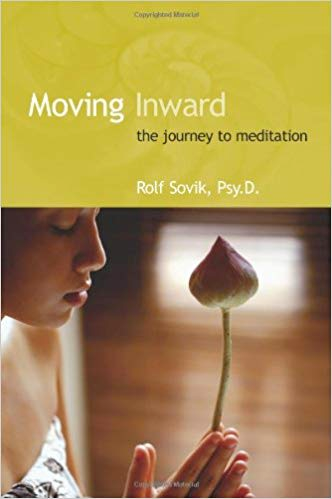
The dedicated practitioner investment for this 10-week course is $180 with advance booking (OR $160 with Early Bird Special)! This course registration includes TEN 75-minute yoga classes, 6:00 to 7:15 pm. This course meets for 10 weeks, Thursdays, April 25; May 2, 9, 16, & 23 [NO session May 30]; June 6, 13, 19, & 26; and July 11 [NO session July 4].
The $18/class rate ($16/class for Early Birds!) is available ONLY for dedicated practitioners pre-registered and paid in full for the entire 10-week course. If space remains after the beginning of Spring Term on April 22, 2019, a casual one-time class for Introduction to Meditation is $23; payment is made in person, cash or check only. Please note all attendance at AHA Yoga offerings require an advance RSVP.
All Yoga & Meditation offerings offered by Virginia Hill at AHA Yoga provide a support to ignite your own inner capacities for transformation. To reserve your place at the dedicated student rate, your investment for the full series must be received prior to attendance (and prior to April 15for EARLY BIRD rate).
All courses are designed for intelligent progression and turning inward; this turn is advanced practice, a a refinement of the mind that cultivates discernment, inner peace, & joy, so you notice and feel more of the beauty in, around, and through you.
To get the most benefits of your practice, commitment is for all 10 weeks of the course term; there are no make-up classes, transfers, or substitutions.
AHA Yoga offerings are not designed to be fitness classes (though fitness is one ancillary result). Instead, all AHA Yoga classes are more traditional yoga courses geared toward mastery of the senses and mind. Hence, all offerings are developed as courses or specialty workshops to this end, and thus full course registration is recommended as only dedicated practice achieves the best results.
Purchase of the tuition pass below for "Introduction to Meditation" confirms your agreement to the following Terms & Conditions as well as the Waiver and Release.
Terms & Conditions of Registration & Attendance:
- If you have any medical concerns, injuries, allergies, are pregnant, or have any changes in such conditions, it is your duty & responsibility to inform your teacher prior to class. You have received permission from your licensed health care provider prior to attendance.
- Your place is held only upon receipt of tuition payment for the full course ($180 investment; $160 for Early Birds) or for the one-class casual rate ($23).
- Payments for Yoga & Meditation courses, classes workshops, and events are non-refundable, unless your class is taken off the weekly schedule due to low enrollment, dire teacher emergency, or unavoidable natural disaster.
- Commitment is for the entire 10-week course to receive the dedicated practitioner rate of $180 (or $160 for Early Birds). There are NO pro-rated tuition fees for absences and NO make-up classes or substitutions for missed days.
- Payments for this series are not transferable to a future class, series, term, or event. All course passes expire the last day of the course in the series; all one-day casual class registrations expire the day of the reserved class session.
- Advise your teacher with 24-hours advance notice if you are unable to attend (text message or e-mail are preferred).
- The teacher holds the right to cancel or reschedule any classes, sessions, or events due to extreme illness or emergencies. Students will be notified of the rescheduled date and every attempt will be made to accommodate each student’s schedule.
- Credit-debit payments are completed online. Cash or check (made out to “AHA Yoga”) is paid in person or mailed (305 East Duval Street, Suite 101, Lake City, FL 32055). There are no on-line payments for single Casual Classes.
- Turn off or put all cell phones on silent.
- Do not leave valuable personal items in your vehicle; personal items may be stored in the prop room.
- Bring your yoga mat; shared mats are available for an additional $2 rental fee and must be cleaned after use (supplies provided).
- Words and energy matter! This is your time to turn inward, and much care has been given to cultivating a sacred space. You and your colleagues are doing deep work when you undertake yoga. Please be respectful of your peers and teacher and maintain the calm, peaceful, and quiet space. This means this is not the time for gossip, complaining, or leftover conversations from work, or any less than tender-hearted, well-intended speech. Take this time and space to breathe and transition into your practice and allow your best self to shine.
- Please take your shoes off at the door of the studio to keep the floor clean and sanitary.
- Be on your mat and ready to go at the starting time.
- It’s best not to eat one hour prior to yoga; for some people, 2 hours are required.
- If anything can be done to make your experience more comfortable, secure, and successful, please let your teacher know (temperature, bathroom needs attention, you need to leave early, special concern, etc.). Suggestions to improve your yoga & meditation experience are always welcome.
- A separate Waiver & Release for AHA Yoga must be completed and signed prior to practice on your first day (unless you are a returning student and have already completed this).
Looking forward to seeing you on the mat. I am so blessed and grateful to be able to bring yoga and meditation to our little neck of the woods; it could not happen without you, so thank you for being a part of this yoga community!
In service,
Virginia Hill, AHA Yoga Teacher
Want to learn more about me and why I am so passionate about sharing this practice? You can find out more about me, my practice, and other yoga & meditation offerings here:
https://virginiahillyoga.com/
Want to learn more about me and why I am so passionate about sharing this practice? You can find out more about me, my practice, and other yoga & meditation offerings here:
https://virginiahillyoga.com/
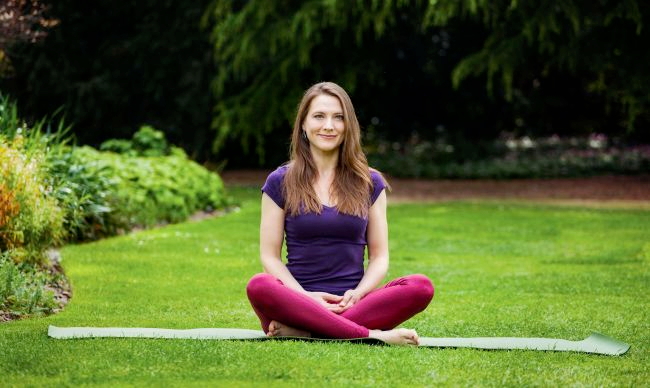
The class takes place on...
- April 25 at 6:00 pm (Thursday)
- May 2 at 6:00 pm (Thursday)
- May 9 at 6:00 pm (Thursday)
- May 16 at 6:00 pm (Thursday)
- May 23 at 6:00 pm (Thursday)
- June 6 at 6:00 pm (Thursday)
- June 13 at 6:00 pm (Thursday)
- June 20 at 6:00 pm (Thursday)
- June 27 at 6:00 pm (Thursday)
- July 11 at 6:00 pm (Thursday)
Reservations
This class series has already finished. Please check our schedule for more classes.
